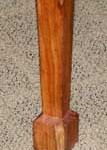Certainly not the most flattering of body parts, many people find themselves uncomfortable about feet.
Whether we’re embarrassed of our own, find feet weird or are just plain grossed out by them, feet rarely tend to be the topic of conversation. Unless, of course, you’re a podiatrist.
The furniture industry has gone to great lengths over the centuries to ensure that isn’t the case for them. Because of these efforts, furniture feet have become desirable and distinguishable features.
Therefore, this brief 2-part series will serve as a bit of a field guide so you can knowledgeably navigate the waters of a definitive furniture feature.
For starters, we’re going to feature some simple, more formal designs.

Spade Foot
This popular style of furniture feet was commonly seen in Sheraton and Hepplewhite periods. the rectangular foot that tapers as it reaches the floor was made popular by Thomas Chippendale (for which the Chippendale period is named after).

Block Foot
Simple in both name and idea, the block foot was a cube that did not marginally exceed the width of the leg it upheld. When paired with the right designs, this foot helps create a clean, modern piece of furniture.

Arrow Foot
This narrow, cylinder-shaped foot was also common during the Sheraton and Hepplewhite periods. A round piece resembling a ball separates the leg from the tapered foot.
